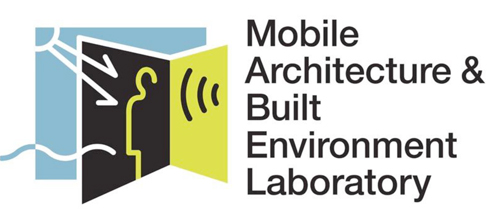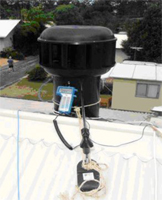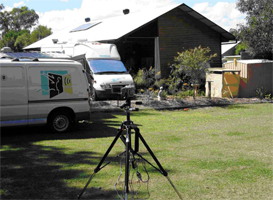Consider what you may think is competition to the universal tile ventilator systems
Whirly vents have moving parts that wear out, a number of static vents that protrude above the roof line as well as whirlybirds are obtrusive and quite unattractive, these all need eaves vents to induce airflow.
Consider this regarding these products, if you have insulation to the mandatory Australian Standards, it will block any air from the eaves entering the roof space, as the insulation sits on the ceiling and extends to the roof tiles allowing no air flow to the roof space from the eaves – this makes eaves vents ineffective and all the ventilation products in the roof space useless.
So eaves vents do not work, whirlybirds do not work and all other static vents and fans do not work without induced air.
Don't be a sucker for a solar fan, when the sun goes down, they go down. This is when you need roof ventilation the most; when you are trying to sleep.

Testing for sala homes 2008.
As you may know, MABEL is the most versatile and comprehensive in-situ testing facility for built internal environments throughout Australia. MABEL is a diagnostic toolkit providing multi-dimensional testing of the key performance criteria of energy, light, sound, and comfort.
MABEL Scope of Project
The Mobile Architecture and Built Environment Laboratory (MABEL) was called upon to investigate the overall comfort and natural passive (mechanical) systems of the SALA Home prototype. The intention was to uncover information on the built environment performance and to highlight ‘fault finding’ instances within the systems and construction provided to the overall house design. MABEL is the most versatile and comprehensive in-situ testing facility for the built internal environment. It is a diagnostic toolkit that provides multi-dimensional assessment of key performance criteria in built environments covering energy, sound, light and comfort. Comfort is inclusive of ventilation and air quality investigations.
Testing the Roof Ventilation System
The Roof Ventilation System comprises of two rotating Wind Turbines set on top of short pieces of ductwork. The manufacturer’s belief is that the wind turbine will expel air in the same manner as a centrifugal fan when it is spinning. However a wind turbine is not a centrifugal fan and does not move air, but is instead moved by the air. This is a fundamental fact not understood by the manufacturers of these products.

With a 300 mm duct installed, with the air velocities measured (see below) a calculated flow rate of 70 litres per second per ventilator is achieved. This equates to a flow velocity of approximately 0.1 metres per second in the wall cavities and the roof. This is considered to be still air in ventilation terms, and is totally inadequate to remove any heat load from the walls and roof.
Recommendations and Conclusions: A more effective roof cavity ventilation system requires further exploration.
Universal Tile Ventilators "Smoothline" ventilators were chosen as SALA Homes preffered
ventilation systems.

